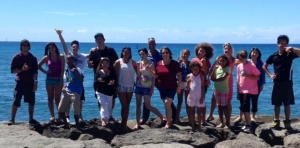Get to Know a Grantee: Hawaiian Youth Services Network
Body
RHY Grantee Supports Young People Across the Hawaiian Islands
As a statewide partnership of youth-serving agencies across the Hawaiian Islands, Hawaii Youth Services Network (HYSN) fosters a system of collaboration, not competition, to aid young people in need. Judith Clark, Executive Director of HYSN for over 20 years, is a former homeless youth herself. She tells Family and Youth Services Bureau (FYSB) staff that the network provides a safety net for kids who slip through the cracks of the system. She expresses her awe at the resiliency of the youth whom HYSN serves: “I’m always amazed at how young people can overcome years of trauma and become caring adults.”
HYSN receives funding through three FYSB Runaway and Homeless Youth (RHY) program grants: Transitional Living Program (TLP), Street Outreach Project (SOP), and Basic Center Program (BCP.) The HYSN subgrantees provide support across Hawaii, and five of the partner agencies operate RHY-funded services. On Oahu, Hale Kipa provides BCP, TLP, and SOP services. On the islands of Maui, Molokai, and Lanai, Maui Youth and Family Services provides BCP, TLP, and SOP services. The Salvation Army Family Intervention Services operates an SOP and TLP on the Big Island. Hale’Opio Kaua’i supports young people through an SOP on Kauai, and Coalition for a Drug-Free Hawaii’s TeenLink program provides BCP services. HYSN also has a staff of five who provide grant management, evaluation, training, and technical assistance to partner agencies’ staff and boards, as well as policy and advocacy work.
Clark reports that the needs of youth in Hawaii are very distinct. A total of 40 to 50 percent of youth served by HYSN identify as Native Hawaiian or Pacific Islander, ethnic groups that are overrepresented in incarceration, high school dropout, and homelessness rates in Hawaii. Clark also notes that a third of juvenile arrests in the state are for runaway charges. Some of these young people come from other Pacific islands, where they have considerably less access to resources and education; they may also have more limited English comprehension. Clark says that the “unified, coordinated, statewide approach” provided by HYSN through FYSB also supports an appropriate allocation of resources between urban and rural homeless youth.
Some Hawaiian urban centers have criminalized homelessness, especially as pandemic restrictions led to many public parks temporarily closing. On some islands, homeless youth live in extremely remote areas and are unable to independently sustain themselves—unlike street youth in Honolulu, who in pre-pandemic times subsisted on tourism and community services. As the needs of youth change across the state, HYSN redistributes RHY grant allocations in an equitable manner, with the objective that “every young person has access to safe and appropriate living conditions,” says Clark.
Typically, HYSN partner agencies serve about 1,000 young people annually through RHY programs; during COVID-19 restrictions of 2020, they were still able to connect with over 500 kids. Hawaiian and Pacific Islander youth demonstrate disproportionately high rates of teen pregnancy, and about 30 percent of the kids HYSN organizations help are pregnant or parenting. Clark has found that differences in culture result in Children & Youth Agency involvement among Pacific Islander families. Additionally, due to unaffordable housing, family homelessness in Hawaii is some of the highest in the nation. HYSN’s SOPs work with other street outreaches to serve the children of these families.
Clark finds cultural competency among staff and boards to be an indispensable component for serving youth. She cautions that homogenously grouping Asian Americans with Native Hawaiians and Pacific Islanders can be problematic, leading to “deceptive data.” Within HYSN, it is very common to see partner organization staff who have experienced homelessness themselves and who reflect the ethnic demography of their clientele. As an ED, Clark implements practices to ensure equitable opportunities at professional growth for ethnically diverse staff from backgrounds with less access to educational resources.
With decades of FYSB’s support, HYSN continues to sustain strong, consistent interagency infrastructure throughout the Aloha State. These federal funds allow Clark to educate government officials and the public about the unique needs of Native Hawaiian and Pacific Islander homeless youth. Her message about HYSN’s youth is simple but powerful. “It’s not ‘us and them,’" says Clark. "Our homeless youth are us. A very large percentage of them are leaving home as a result of child abuse and neglect, untreated mental health and substance abuse needs. If we could take care of those needs, we could solve most of our homeless problem.”
Learn more about Hawaii Youth Services Network:
